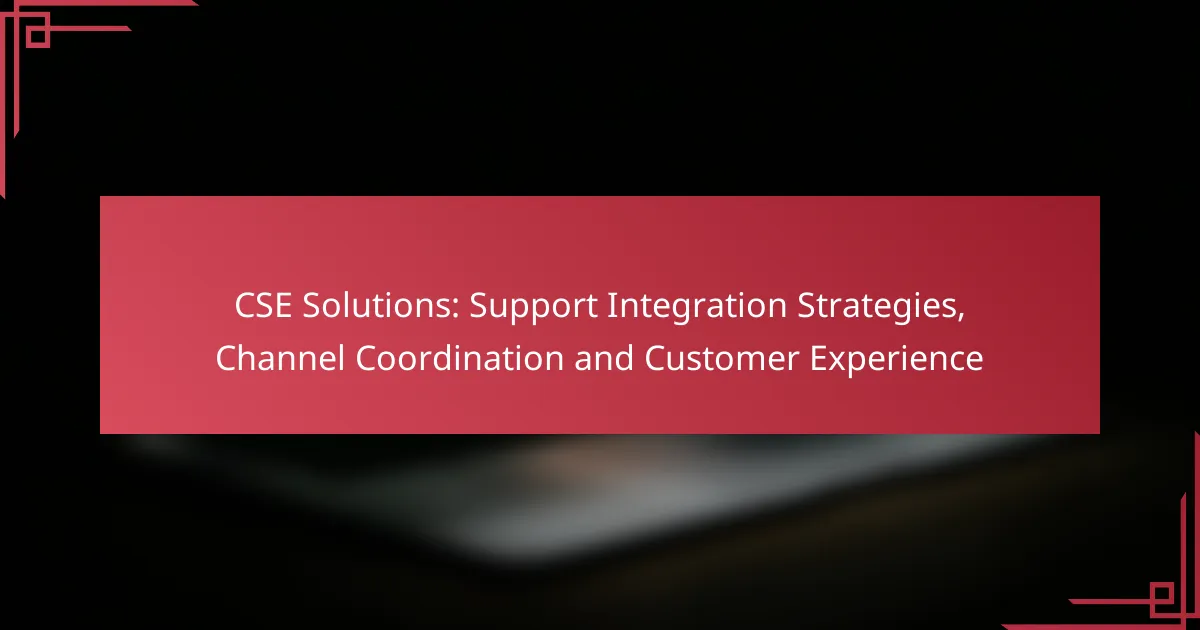Effective Customer Support Experience (CSE) solutions in the UK emphasize the integration of support systems and the enhancement of communication channels to elevate customer satisfaction. By streamlining operations and personalizing interactions, businesses can create a more engaging and cohesive customer experience. Implementing these strategies not only fosters collaboration among teams but also ensures that all members are aligned with the company’s goals, ultimately leading to improved service quality.

What are effective CSE solutions for customer experience in the UK?
Effective Customer Support Experience (CSE) solutions in the UK focus on integrating support systems, enhancing communication channels, and personalizing interactions to improve overall customer satisfaction. These strategies help businesses streamline their processes and foster a more engaging customer experience.
Integrated support systems
Integrated support systems combine various customer service platforms into a cohesive unit, allowing for seamless information flow and improved response times. By utilizing tools like CRM software, businesses can centralize customer data, making it easier for support teams to access relevant information quickly.
Consider implementing solutions that allow for ticketing, chat, and email support to work together. This integration reduces customer frustration and ensures that all interactions are tracked, leading to more efficient service delivery.
Omni-channel communication
Omni-channel communication ensures customers can interact with a brand through multiple channels, such as social media, email, phone, and live chat. This approach allows customers to choose their preferred method of communication, enhancing their overall experience.
To implement an effective omni-channel strategy, ensure that all channels are interconnected. For example, a customer should be able to start a conversation on social media and continue it over email without losing context. This consistency builds trust and satisfaction.
Personalized customer interactions
Personalized customer interactions involve tailoring support responses based on individual customer preferences and history. This can significantly enhance customer loyalty and satisfaction, as customers feel valued and understood.
Utilize customer data to inform interactions, such as addressing customers by name and referencing their previous purchases or inquiries. Simple personalization techniques can lead to a more engaging experience and foster long-term relationships.
Data-driven insights
Data-driven insights leverage analytics to understand customer behavior and preferences better. By analyzing customer interactions, businesses can identify trends and areas for improvement in their support services.
Invest in tools that provide real-time analytics and reporting. This allows teams to make informed decisions, optimize processes, and enhance the overall customer experience based on concrete data rather than assumptions.
Proactive issue resolution
Proactive issue resolution involves anticipating customer needs and addressing potential problems before they escalate. This strategy can significantly reduce customer frustration and improve satisfaction levels.
Implement systems that monitor customer interactions for signs of dissatisfaction or recurring issues. For instance, if a customer frequently contacts support about a specific problem, reaching out with a solution before they need to ask can demonstrate a commitment to their satisfaction.

How can businesses improve channel coordination in the UK?
Businesses in the UK can enhance channel coordination by implementing effective communication strategies, fostering collaboration, and providing ongoing training. These approaches help streamline operations and ensure that all team members are aligned with the company’s goals.
Centralized communication platforms
Utilizing centralized communication platforms is essential for improving channel coordination. Tools like Slack or Microsoft Teams allow teams to share information in real-time, reducing the chances of miscommunication. By centralizing discussions, businesses can ensure that everyone has access to the same information and updates.
When selecting a platform, consider user-friendliness and integration capabilities with existing tools. A well-chosen platform can significantly enhance productivity and reduce response times across channels.
Regular training sessions
Regular training sessions are crucial for maintaining effective channel coordination. These sessions should focus on best practices for communication, collaboration, and the use of tools. By investing in training, businesses can ensure that all employees are equipped with the skills needed to work efficiently across various channels.
Consider scheduling training quarterly or bi-annually to keep skills fresh and to introduce new tools or processes. Engaging employees in these sessions can also foster a culture of continuous improvement and teamwork.
Collaborative tools
Implementing collaborative tools can significantly enhance channel coordination. Tools like Trello or Asana help teams manage projects and track progress, ensuring that everyone is on the same page. These platforms allow for task assignment, deadline tracking, and status updates, which are vital for effective collaboration.
Choose tools that align with your team’s workflow and encourage regular updates. This practice helps to identify bottlenecks early and promotes accountability among team members, ultimately leading to smoother operations.

What are the key strategies for support integration?
Key strategies for support integration focus on creating a seamless experience for customers by aligning various support channels and departments. This involves managing customer data effectively, fostering collaboration across teams, and establishing feedback mechanisms to continuously improve service quality.
Unified customer data management
Unified customer data management involves consolidating customer information from various sources into a single, accessible platform. This ensures that all support teams have the same up-to-date information, which enhances response times and service accuracy.
To implement this, consider using a Customer Relationship Management (CRM) system that integrates with your support tools. Regularly update and maintain this database to avoid discrepancies and ensure data integrity.
Cross-departmental collaboration
Cross-departmental collaboration is essential for effective support integration, as it allows different teams to share insights and strategies. Regular meetings and shared platforms can facilitate communication between departments like sales, support, and product development.
Encourage team members to participate in joint training sessions and workshops to foster a culture of collaboration. This approach not only improves customer service but also helps in identifying and resolving issues more efficiently.
Feedback loops
Establishing feedback loops is crucial for understanding customer needs and improving support services. This involves collecting feedback from customers after interactions and using that data to make informed adjustments to support processes.
Utilize surveys and follow-up calls to gather insights, and ensure that this feedback is analyzed and acted upon. Regularly review feedback trends to identify areas for improvement and celebrate successes to motivate your team.

What criteria should businesses consider for selecting CSE solutions?
Businesses should consider scalability, compatibility with existing systems, and user-friendliness when selecting Customer Service Experience (CSE) solutions. These criteria ensure that the chosen solution meets current needs while being adaptable for future growth and integration.
Scalability
Scalability refers to the ability of a CSE solution to grow alongside a business. Companies should look for solutions that can handle increasing volumes of customer interactions without a decline in performance. A scalable system can accommodate additional users, features, or integrations as the business expands.
When evaluating scalability, consider whether the solution can support a range of customer service channels, such as chat, email, and social media. A good practice is to choose a solution that can easily scale from serving a few hundred to potentially thousands of customers.
Compatibility with existing systems
Compatibility with existing systems is crucial for seamless integration and operational efficiency. Businesses should assess how well a new CSE solution can work with their current software, such as CRM systems, databases, and communication tools. This ensures that data flows smoothly between platforms without requiring extensive modifications.
To evaluate compatibility, consider conducting a compatibility audit of your existing systems. Look for solutions that offer APIs or built-in integrations with popular software to minimize disruption during implementation.
User-friendliness
User-friendliness is essential for both customer service agents and end-users. A CSE solution should have an intuitive interface that allows agents to quickly navigate and resolve customer inquiries. This reduces training time and enhances overall productivity.
When assessing user-friendliness, consider conducting trials or demos with your team. Gather feedback on the ease of use and identify any potential challenges. Solutions that prioritize user experience often lead to higher satisfaction rates among both staff and customers.

How do CSE solutions impact customer satisfaction?
CSE solutions significantly enhance customer satisfaction by streamlining support processes and improving interaction quality. By integrating various communication channels and optimizing response strategies, businesses can provide timely and effective assistance to their customers.
Enhanced response times
Enhanced response times are a crucial benefit of CSE solutions, as they enable businesses to address customer inquiries more swiftly. By utilizing automated systems and intelligent routing, companies can reduce response times to low tens of milliseconds in ideal scenarios.
To achieve these improved response times, organizations should implement chatbots for initial customer interactions, allowing human agents to focus on more complex issues. Regularly monitoring and analyzing response metrics can help identify bottlenecks and areas for improvement.
It’s essential to balance speed with quality; rushing responses may lead to misunderstandings or dissatisfaction. Aim for a response time that meets customer expectations, typically within single-digit minutes for urgent queries, while ensuring that the information provided is accurate and helpful.



